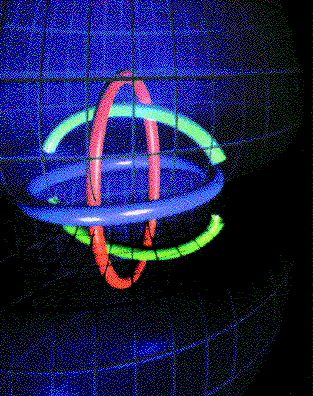
Electronics
STC researchers have studied several emerging technologies in electronics, including semiconductor materials, advanced liquid crystal displays, quantized electronic structures, and new sensing methods for scientific instruments. At the Center for Synthesis, Growth, and Analysis of Electronic Materials, researchers have worked on projects to improve semiconductor materials-a technology with many applications in industry. For example, center researchers have developed a silicon cleaning process that will be used in a commercial product by the Balzers company.As the need increases for more portable, energy-efficient electronic devices, the circuitry in these products must be significantly reduced in size. Setting the trend to make electronic circuits smaller is the Center for Quantized Electronic Structures (QUEST); it provides consulting to and collaboration with a number of companies, including Hewlett-Packard (high-speed electronic devices) and IBM (optoelectronics research and nanoscale lithography). Researchers at the center have succeeded in making a web of electronic wires so tiny that they are constructed atom by atom. The creation of these quantum structures has received favorable response from industry. IBM donated a $1 million electron-beam lithography system to generate additional collaborative research with QUEST.
Another center is helping to make electronic devices smaller and more energy efficient. In the past year, researchers from five companies have worked at the Center for Advanced Liquid Crystalline Optical Materials, collaborating to improve liquid crystal technology. Researchers have developed a technology that could revolutionize portable displays by making them smaller, lighter, and more efficient. This front- lit display technology could be used for portable computers, electronic books, and other hand-held devices.
The scientific questions addressed by many STCs require the development of new sensing methods. For instance, the Center for Particle Astrophysics is collaborating with Loral-Fairchild to improve large- format charge-coupled devices. Lockheed and Conductus are other companies collaborating in the development of new particle detectors ("cryogenic detectors"). Center researchers are also working with the Center for Quantized Electronic Structures and Hughes in the design of new high-frequency, low- noise, high-electron mobility transistors.
High-performance Computing
Because American researchers have developed many new technologies in high-performance computing, American computer manufacturers have had an advantage over their global competitors. Several STCs focus on ways to maintain this advantage in key areas of this critical industry, including parallel computing, computer graphics and scientific visualization, speech, language and vision, and computational mathematics.The Center for Research on Parallel Computation (CRPC) has provided groundbreaking models in programming languages, parallel algorithms, programming support, and scientific applications programs for parallel supercomputers, the fastest and most powerful computers currently available. For example, Intel has credited CRPC researchers with pioneering features of the operating systems and software systems provided with its parallel supercomputers. Sponsored by the CRPC, the High Performance Fortran Forum (HPFF) is creating a standard Fortran programming language for parallel supercomputers that will increase the acceptance and commercial value of these machines. The HPFF brings together participants from academia, government, and industry, including every major manufacturer of parallel computer systems.
The Center for Discrete Mathematics and Theoretical Computer Science has also developed powerful software to solve large computational problems. In collaboration with researchers from the CRPC and AT&T, center scientists have used parallel computing to find the most efficient way to drill 3,038 holes in a circuit board (commonly known as the "Traveling Salesman Problem"). Researchers have also worked with industry in developing simulation programs that test and analyze new telecommunication networks before they are installed and in developing a digital timestamp to prevent the creation of illegally modified electronic documents.
 |
| Scene from the mathematical visualization, "Knot Not." Folding and gluing a cube's faces about the colored axes yields this orbitfield - The Geometry Center |
STC efforts bring together representatives from academia, government, and competing corporations to create standards for commercial products.
Research Collaboration in Leading-Edge Technologies
Sites & Affiliations | Leadership | Research & Applications | Major Accomplishments | FAQ | Search | Knowledge & Technology Transfer | Calendar of Events | Education & Outreach | Media Resources | Technical Reports & Publications | Parallel Computing Research Quarterly Newsletter | News Archives | Contact Information
| Hipersoft | CRPC |
© 2003 Rice University
|